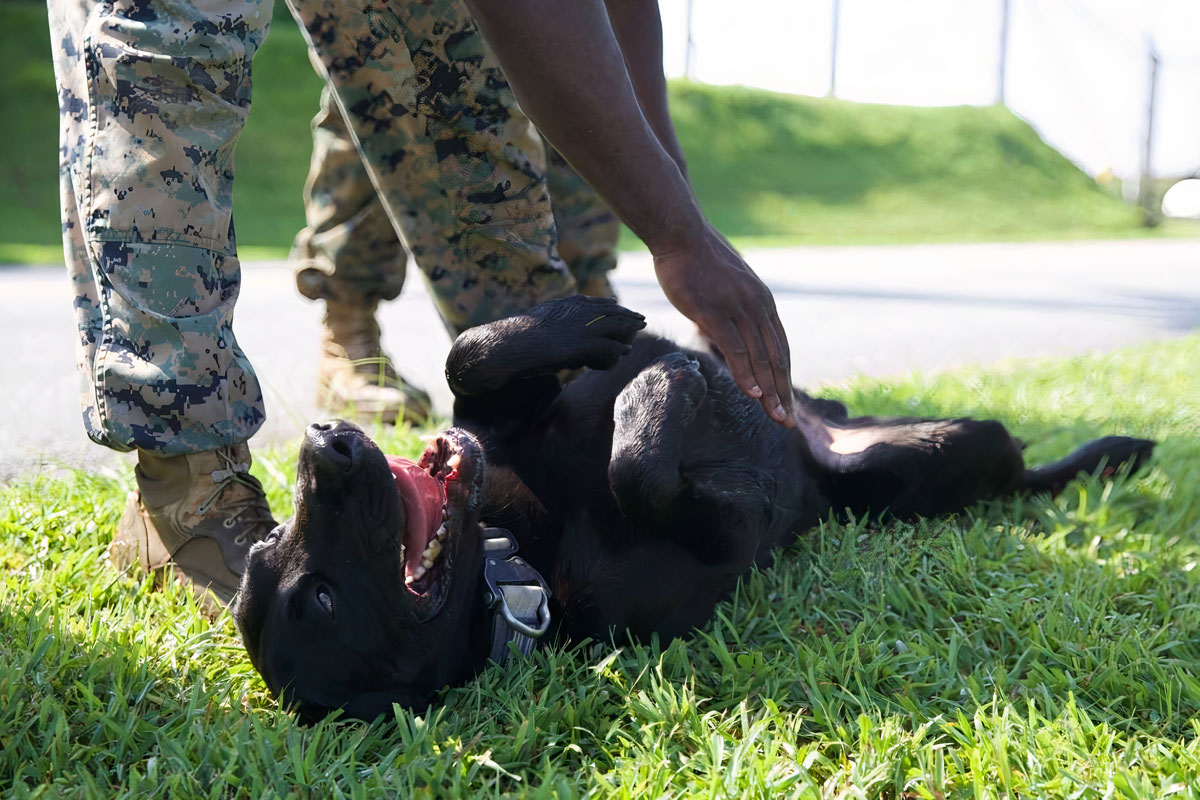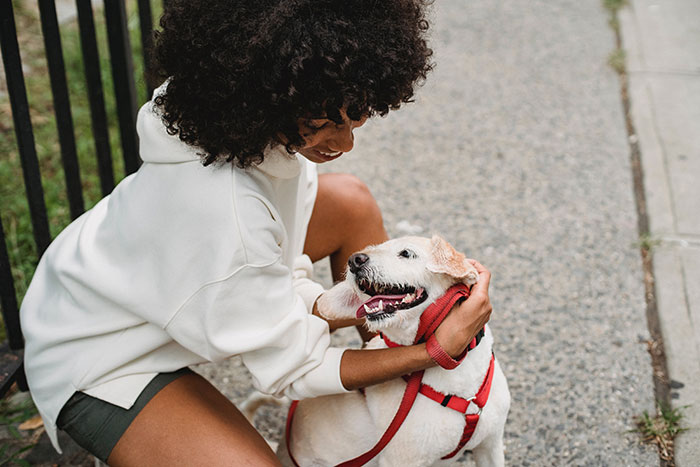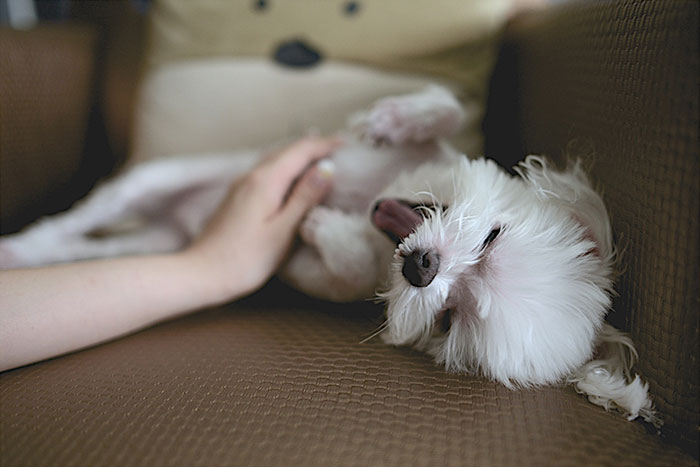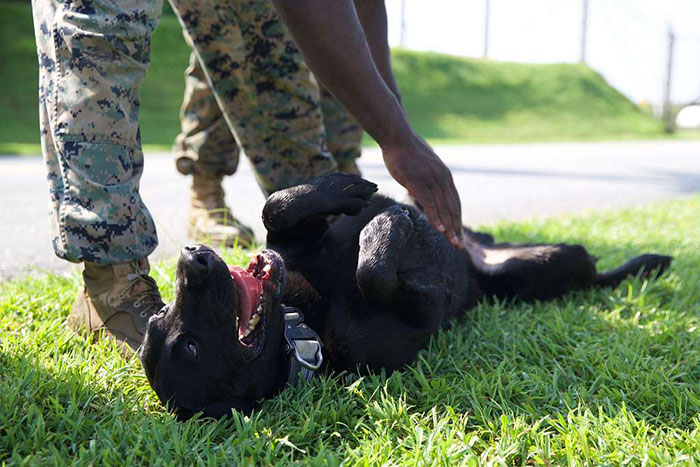One of the most notorious and serotonin-boosting connections is one that exists between a human and a canine. Humans have evolved since the beginning of time, all with their trusted companions at their side.
Along the way, humans have made an increased effort to build trust and understanding with their dogs, resulting in an impenetrable foundation of trust being built.
- Dogs express trust through belly rubs.
- A dog's belly expose can signal submission or invitation.
- Belly rubs release endorphins and oxytocin in dogs.
- Observe a dog's body language before giving belly rubs.
- The scratch reflex is an involuntary response in dogs.
With any interaction with a dog who has been in your life for ten years or a pup you just met, your ability to read their body language is going to be the determining factor in which your experience with them flows.
Image credit: Samson Katt
Learn what a dog is actually asking of you when they roll over on their back – are they just trying to appease you, or are they ready for a belly rub? Taking the time and the diligence to observe dog behavior is, undoubtedly, the main element that will keep you both safe, happy and fulfilled in the long run.
A canine’s body language has the ability to tell you almost everything that he is feeling, since they don’t exactly have the vocabulary to voice their thoughts. A happy dog is a relaxed one and it’s important to understand what it actually means when your dog flops over on his back with his legs up in the air.
There are a couple options here: he is nervous and submitting to you, or he is sending out the invitation for you to give him the perfect belly rub!
Some dogs enjoy belly rubs while others find it too invasive and threatening. The difference between submission and a request for rubs and scratches is ultimately going to determine your approach to the situation as a whole.
The information provided herein is for informational purposes only. Please refer to our disclaimer for more details..
Why Does a Dog Show His Belly When Approached?
Image credit: pxhere.com
An anxious dog may roll on their back as you approach to say, “Hey, I mean no harm, but please don’t touch me!” With that, it’s imperative that you understand that the dog is putting himself in a very vulnerable position.
This appeasing behavior can also be paired with constant lip licking, a tucked tail, eyes so wide that you can see the whites, and tension throughout the entire body. Dogs who expose their bellies in this manner are not sending you a friendly invitation for a tummy rub- it’s their polite way of avoiding conflict.
On the other hand, we have the dogs who are more than happy and confident to ask you for the best belly rub you have to offer by showing you their vulnerable belly as a way of greeting. A dog who is comfortable enough to be so forward in their body language is one that has a relaxed, open mouth, an easy-going tail wag and a loose stance.
Why Does Your Dog Want a Belly Rub?
Like most humans enjoy massages, a belly rub to a dog can feel great and soothing, especially in such an area that’s difficult for them to reach on their own. Even the hair stimulation on their stomach can feel great! Imagine having an itch on your back and no one to help you.. the torture!
When you rub your pup’s belly, it can release endorphins and give a boost of oxytocin for both you and your canine companion. Win, win! When your dog is comfortable enough to demand affection from you by rolling over on his back, consider your venture for building trust an absolute success!
Dogs and humans are not so far different from each other when it comes to seeking connection. At some point, we all crave positive attention or an affectionate touch, which is one of the reasons why dogs can display their love and trust in their owners by asking for a belly rub.
A dog’s need to have their tummy scratched can range from him just needing help with an itch to seeking deeper connection with his owner by requesting a physical interaction that involves a variation of pats, scratches and rubs.
How to Give a Great Belly Rub
Image credit: Defense Visual Information Distribution Service
Before you set yourself up to give the best belly rub of all time, make sure to step back and give the dog, whether it’s your own or a neighbor’s, a thorough body language assessment. If all signs are positive, then you have one job left to do: get in there and give a good belly rub! Some dogs who typically love having their tummy rubbed might not be in the mood, so try not to take it personally- they’ll come around on their own time.
Just like you want your dog to reflect positive body language, you need to do the same for yourself.
- As the dog goes belly-up, get down to their level in a relaxed position to let them know that you accept their invitation into their personal space.
- Then, use your fingertips to create large circles around the dog’s belly.
- After a few seconds, pause, and assess the dog’s body signals to address if you should continue.
- Some dogs may lay on their back until your arm gets tired while others will feel satisfied with just a few seconds of belly rubs.
- You can try changing up the type of pressure, patterns and speed applied by your hand to draw out different, positive responses. Some dogs will even paw at you as their way of begging you not to stop!
What Causes the Scratch Reflex During a Belly Rub?
You might feel like The Chosen One if you’re scratching a dog’s belly and they start kicking their leg repeatedly with their tongue lolling to the side. The scratch reflex is an interesting, involuntary phenomenon that leaves pet owners convinced that they have hit the sweet spot with their pup.
Made up of a bunch of nerves, the reflex originated in a fashion that allowed dogs to ward off fleas and other irritants from their vulnerable belly. When that special spot is scratched on a dog’s tummy, a game of telephone begins: the nerves communicate to the spinal cord, which forces the leg to engage the scratch reflex.
The bundle of nerves that kicks off this type of reflex is only located on certain areas of the belly, so it can’t be stimulated in other popular petting locations, like the shoulders or neck.
The most interesting aspect of the scratch reflex is that the signal from the nerves, to the spinal cord, down to the leg, is that it completely skips the brain in the communication process. This means that your dog isn’t actually cognitively aware that his leg is moving!
Oftentimes, you’ll notice that even he seems surprised or confused at the movement. Owners generally find their surprise very endearing. In final comparison, the scratch reflex can easily be compared to the same reflex your doctor elicits when they tap your knee with a reflex hammer.
It’s going to happen, whether you like it or not, when that sweet spot is hit. The involuntary reflex never fails to make everyone smile and it can certainly leave your dog knowing that when his leg starts pedaling, he is in for a real treat!







9
1